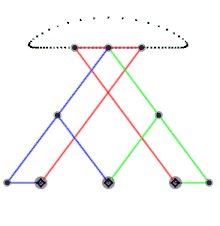Chebyshev Mechanism
The Chebyshev mechanism , also known as the Chebyshev parallelogram (the spellings Chebyshev , Chebyshev or Chebyshev are also found in transcriptions ), is a three-part coupling gear that converts the rotary motion into an approximately straight one ( straight line ). It was discovered in the 19th century by the Russian mathematician Pafnuti Lwowitsch Chebyshev , who was researching the theoretical problems of kinematic mechanisms. The conversion of a rotary motion into a linear motion is part of the more general problem of converting a rotary motion into any motion.
The range of linear movement is defined by the point - the center point of the rocker - that moves between the two end points of this gear. The deviation from the ideal linear movement is small on this route.
The relationship between the individual lengths corresponds to the following expression:
From the relationship shown, it follows that the rocker is vertical when it has reached one of the end points of its movement.
Mathematically, the lengths are related as follows:
Limits the input angle
The limits of the input angle are in both cases (L2 or L4 as input angle):
other names
- Chebyshev parallelogram
- Cross link from Chebyshev
Similar mechanisms
Individual evidence
- ^ Francis Moon: Cross Link Straight-line Mechanism. Cornell University, January 1, 2001, accessed February 13, 2014 .
- ↑ Straight Line Generators - Tchebicheff's Linkage. Brock institute for advanced studies, September 3, 2007, accessed February 13, 2014 .
- ↑ Digital mechanism and gear library: Applied gear theory Schroedel, Hannover a. a., 1952. page 178
Web links
- Chebyshev Mechanisms website (Russian, English, French)








